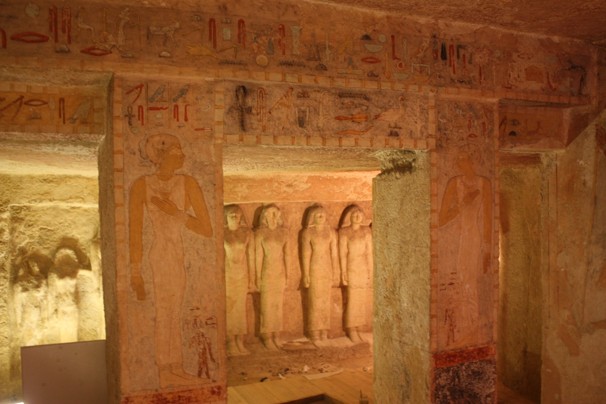More than 4,500 years since the paint was first applied, the reds, yellows and blues still stand out on the walls of the tomb of Queen Meresankh III.

Decorating the walls all around are paintings, reliefs and statues of Meresankh, draped in a leopard-skin cloak, standing beside her mother in a boat, pulling papyrus stems through the water or being entertained by musicians and singers.
Egypt’s tourism industry has been battered since last year’s revolution, but here, beside the pyramids of Giza, officials are trying to attract the visitors back.
The tomb of Meresankh, whose name means lover of life, will be opened to the public for the first time in nearly 25 years later this year, while five other tombs of high priests — buried under the desert sands for decades — will be thrown open.
“We want to give people a reason to come back, to give them something new,” said Ali Asfar, director general of archaeology on the Giza plateau.
Meresankh was a woman whose life was intimately bound up in the pharaoh’s incestuous rule. Her tomb lies a stone’s throw east of the Great Pyramid of her grandfather Khufu, better known as Cheops.
Her parents were brother and sister, and she married another of Khufu’s children — her uncle, Khafre, better known as Chephren, who built the second-largest pyramid here.
But Meresankh died suddenly, before her mother, who gave her own burial chamber for her daughter’s use.
American archaeologist George Reisner wrote of his delight at the discovery in 1927 as his team poked their heads through a gap at the top of the sand-filled doorway.
“Our eyes were first startled by the vivid colors of the reliefs and inscriptions around the northern part of this large chamber. None of us had ever seen anything like it,” he wrote in the magazine of the Museum of Fine Arts in Boston, where a statuette of Meresankh and her mother is housed.
Smaller but still interesting
On the other side of the Great Pyramid, the western cemetery houses the tombs of high priests, such as Kaemankh, the royal treasurer and keeper of the king’s secrets.
It took site inspector Ashraf Mohie El Din and a team of more than 50 people around five months to clear about three feet of sand that had blanketed the area and clean the tombs.
Mohie El Din said that climbing the ladder into Kaemankh’s burial chamber was “one of my favorite adventures.”
It is not hard to see why. On the walls, more vivid and colorful paintings show fishing on the Nile, a cow being slaughtered and another giving birth. In the cramped space around the sarcophagus, Mohie El Din shines his torch on an “ancient party” with dancers and musicians playing harp and flute. Just above, carpenters make a bed and a chair.
To the south of Cairo, authorities are also planning to reopen the famous Serapeum at Sakkara, a massive underground temple where sacred bulls were thought to have been buried in the huge granite and basalt sarcophagi — each weighing 60 to 100 tons — that sit in chambers flanking the long galleries.
Smart wooden walkways and metal arches designed by subway engineers show the fruits of a 10-year restoration project.
Above ground, however, the pyramids of Sakkara, smaller than those at Giza but still a popular tourist attraction in normal times, are almost deserted. The parking lots outside the rows of carpet shops lining the route from Cairo are empty, business is down to less than a tenth of what it was two years ago, shopkeepers say.
Kamal Wahid, director of antiquities at Sakkara, blames the media for training its cameras exclusively on Tahrir Square, the center of protests that toppled president Hosni Mubarak last year. But tour operators say the government needs to do much more to restore security, clean the streets and regulate the traffic that brings constant gridlock to Cairo.
‘I am selling an image’
Opening tombs will not solve the problem on its own, said Elhamy el-Zayat, chairman of the Egyptian Tourism Federation, in a country that already has an almost endless choice of archaeological treasures outside the well-traveled tour-bus route.
“I am selling an image, I am selling a dream,” he said. “But customers will see what they watch on TV.”
Cultural tourism was hit much harder by Egypt’s revolution than were its Red Sea resorts, which now account for 92 percent of tourists visiting this country, Zayat said. Tourist arrivals are down by about 35 percent from pre-revolution levels, he said.
The number of visitors to the temples of Luxor and Aswan on the Upper Nile has dropped sharply, and nearly a third of the people directly employed in the tourism industry have left. Many of the younger ones have gone to call centers, he said, robbing the industry of English-speaking guides who may be tough to replace.
Nevertheless, Zayat said, Egypt’s tourism industry will recover, just as it did after the massacre of 62 people, mostly tourists, by Islamist extremists in Luxor in 1997.
“Egypt will always come back,” he said. “It always has — not because we have done something remarkable, but because Egypt is attractive.”
Author: Simon Denyer | Source: The Washington Post [July 29, 2012]